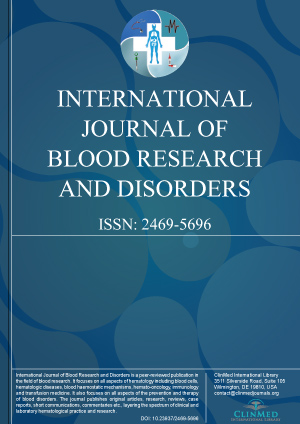Open Access DOI:10.23937/2469-5696/1410077
The Severity of Sickle Cell Anemia in Men - The Action of Molecular and Biochemical Markers
Jonathan de Oliveira Rios, Thais Fernandes Ribeiro, Gabriel Felipe Arantes Bertochi, Clarisse Lopes de Castro Lobo and Claudia Regina Bonini Domingos
Article Type: Original Article | First Published: June 23, 2022
Sickle cell disease is characterized by a very heterogeneous clinical course among patients with the same mutations for sickle cell hemoglobin (HbS). Sickle cell anemia (SCA) is a hereditary hemoglobinopathy caused by the homozygosity of a point mutation in the beta-globin gene, which leads to the substitution of glutamic acid for valine in the sixth position....
Open Access DOI:10.23937/2469-5696/1410076
Clinical Presentations and Predictors of Severe Sickle Cell Disease among Patients Who Attended Muhimbili National Hospital Dar-Es Salaam, Tanzania: A Retrospective Study
Eunice Andrew Shija, Clement Kabakama, Benson Peter Mugaka, Yu-jiao Xiang1 and Yan Shi
Article Type: Original Article | First Published: May 04, 2022
Inherited hemoglobinopathies led by Sickle Cell Disease (SCD) are key contributors to the anaemia burden in Sub-Saharan Africa (SSA). In Tanzania, an estimated six out of one thousand newborns are born with SCD, making Tanzania the fourth country with the highest burden of SCD patients in the world and the third in Africa after Nigeria and the Democratic Republic of Congo (DRC) (Nigeria 85,000, Democratic Republic of Congo 42,000 and Tanzania 11,000). At present, curative options for sickle cell...
Open Access DOI:10.23937/2469-5696/1410075
Applicability of the Neutrophil/Lymphocyte Ratio in Behavioral Studies
Romes Bittencourt Nogueira de Sousa, Luiz Henrique Alves, Vithoria Caetano Carmo, Cintia da Silva Manso, Fagner Medeiros Alves, Ana Gabriella Pereira Alves, Denise da Silva Pinheiro, Natália Carvalho de Camargo, Laura Carvalho de Camargo, Hully do Nascimento Segatti and Maria Sebastiana Silva
Article Type: Review Article | First Published: April 21, 2022
The balance of neutrophilic and lymphocytic populations in the body is sensitive to neuroendocrine changes present in acute and chronic emotional stress, influencing a range of behaviors intrinsically related to real or potential environmental stressors. In this sense, the Neutrophil/ Lymphocyte Ratio (NLR) is a simple and low-cost tool, derived from the analysis of the blood count, capable of showing changes in several health parameters, since it is related to the pro-inflammatory status of the...
Open Access DOI:10.23937/2469-5696/1410074
Melphalan and Cytarabine as a Salvage Therapy in Children with Relapsed or Refractory Acute Leukemia
Malaval Carmen Isolde, MD, Queudeville Manon, MD, Döring Michaela, MD, Hartmann Ulrike, Dr. Pharm, Lang Peter, MD, Handgretinger Rupert, MD and Ebinger Martin, MD
Article Type: Research Article | First Published: March 16, 2022
In refractory or relapsed acute leukemia the achievement of a complete remission by a salvage therapy and the performance of allogeneic hematopoietic stem cell transplantation (HSCT) is in most cases the only treatment by which long term disease-free survival can be accomplished. With current salvage regimens a 5 year overall survival rate of 29% is obtained in children with relapsed acute myeloid leukemia (AML) and a 10 year overall survival rate of 36% in children with relapsed acute lymphobla...
Open Access DOI:10.23937/2469-5696/1410073
Aplastic Anemia-Related Mortality in Brazil, 2000-2018
Augusto Hasiak Santo
Article Type: Case Report | First Published: January 14, 2022
Aplastic anemia (AA) is a rare and serious disease, potentially life-threatening, that affects hematopoietic stem and progenitor cells and is characterized by pancytopenia and a hypoplastic bone marrow. The development of AA result from the destruction of hematopoietic cells by three main mechanisms, including direct environmental injury, dysregulated immune system, and primary inherited or acquired bone marrow failure syndrome. There are no AA specific markers then the diagnosis is reached by e...

